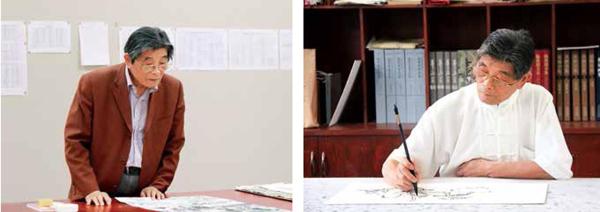笃敬忠诚力推诗书画印
2018-10-11郭闻
郭闻
推开杭州国画院院长室的门,一位老者从案前抬起头招呼:你来了。熟稔得像是我们已经认识了很久。其实这是我第一次拜访书法家金鉴才。
光说书法家其实不太确切,在书画界,金鉴才先生被称为“诗书画印”四绝奇才。当然,他自己并不承认这个封号,觉得并没有达到这样的高度。但推广或者说恢复诗书画印一体的中国文化传统理念,是他一生努力的方向。
这个努力,与他受老师潘天寿的影响分不开。当年,潘先生在浙江美院(中国美术学院前身)恢复中国画系的时候,率先进行中国画分科教学,倡导传统文化素养和诗书画印“四全”,认为“画画的人,不能局限于画画一面,对诗文、书法、画论、画史等等方面的学识必须很好研究。学识要博,见闻要广”,强调“中国画专业应把诗词、书法、篆刻等列为正式课程”。
金先生从学画开始至今60年,一直在坚持这个观点。在无数的讲座中,他总是在阐述这一观点,力图让更多的人接受。
進入书画界,对于金鉴才来说也许是个意外。16岁初中毕业的时候,因家庭困顿,他应父亲的要求报考了所需费用不高的浙江美院附中,没想到学习书画用的纸张、颜料等材料费却让他差点承受不起。幸运的是,在这一路求学过程中,他受到周沧米、吴茀之、潘天寿、张宗祥等大家名师潜移默化的影响,凭着“咬牙再坚持一下下”的念头,最终得以结缘中国书画六十载。
这六十载,不仅是金鉴才研习中国书画的六十载,更是他系统钻研中国传统文化的六十载。在他的身上,传统文人的气质由此表现得十分明显,也因此,让我这样初次见面的后生晚辈,在与他的交谈中感觉如沐春风。
但是,礼仪的周到和待人的宽厚,并不意味着对做事要求的放松,相反,我深深地觉得,老先生对待工作非常认真,要求很高。
做事做人 一丝不苟
我去的时候,他正在为一场“扇里清风,夏日送凉”公益活动忙碌着,这是杭州国画院美术馆成立五周年的纪念活动。按照金先生的构想,单纯的纪念活动没意思,像是关起门来自娱自乐,不如邀请杭城书画家创作140幅扇面书画,现场赠送给市民。这样既可以让人走进美术馆,还可以让更多人感受到中国书画之美。
所以他对这次活动特别重视,认真到要了解整个活动的每一步细节。从起始时间到活动流程,从赠送程序到现场秩序,他都一一过问。4位具体操办活动的年轻画师被他的一个个问题问得满头大汗,赶紧进一步完善活动预案。
这些年轻人,或者是他的学生,或者是他亲手招进画院的画师。要想在杭州国画院做画师,不是件容易的事,因为这所画院很不一般。
2013年金鉴才向杭州市委、市政府的建言:作为中国画十分发达的浙江,需要一所专业的中国画院。
在古稀之年建言并主动挑起这副显然份量不轻的担子,是因为,金先生胸中始终有一团火——完成潘天寿老师倡导的诗书画印一体的遗愿;更是因为,儒家所提倡的身体力行的士之精神,已深入金鉴才的骨髓。
画院正堂那副“笃敬忠诚坚定文化自信,诗书画印推行国艺重光”院训对联,书写的正是金先生的心中之愿。
承载了文化传承之担、教化社会之责的杭州国画院,它的体制、理念和运行模式也与其他画院不太相同。
与其他画院拥有大量专职画师不同,杭州国画院不设专职画师,仅有在编的5名创作人员,他们和工作人员一样,都需要正常上班,且要分担具体的行政事务工作。相较其他画院专职画师的自由,这5名创作人员入职之初还得全脱产学习一年,内容涵盖经史子集等传统文化的各个方面,书画等技艺反而是其次。这正印证了潘天寿曾经提出的“四分读书,三分写字,三分画画”的主张。当年,潘天寿也正是对年轻的金鉴才这么要求的,要求他“在年轻的时候多读点书”。
说起这段往事,金老爷子说:我现在也是这样要求年轻画家的,以后这些年轻人会感谢我的。
书画教化 赢得未来
在杭州国画院,专职画师并不意味着仅是吟诗作画为文刻印,他们还需要承担大量的社会活动和事务性工作,哪怕他们其实已经是书画界小有名气的中青年书画家。比如说具体操办着那场公益活动、不断核算着活动到底举办多长时间为好的王菂,操持着办公室日常管理的吴常青,担任着院党支部书记的赵天叶,是花鸟专业博士;又比如说负责所有教学事务和创作培训中心日常工作的虞仲韦,是山水专业博士……
不以名为傲,不以琐碎而烦,踏踏实实地做人做事,这便是杭州国画院的特点,也是受人尊敬之处。
而由此而来的是金老爷子对大家的高标准、高要求。“换位思考、站到对方立场上去想”,是他对每一场活动的要求。
自成立以来的五年里,画院举办了大大小小几十场主题展出;定期举行的上百场国学夜校公益讲座,请来的都是知名学者专家。
在求学的时候,金先生曾经评价他的老师周沧米先生,“真算得上是争夺下一代的高手”,因了周先生的不厌其烦、循循善诱,他最终爱上了中国画。
去年,杭州国画院特意建立了少儿画会,通过培养少儿对中国画艺术的热爱,从小做起,提高民族的文化自信,也自存了“争夺下一代”的用意。今年暑假,画院专门推出了少儿书画夏令营。
金先生说,我们办夏令营,并不是为了让孩子在这短短的时间里能够学到什么画画的技法,是为了让他们了解什么叫中国画,什么是中国传统文化。在这个夏令营里,孩子们首先学的是坐姿,是礼仪,是学习的态度。比如写一次字,笔怎么放,怎么坐,写完怎么收拾,凳子怎么放等等。
更难能可贵的是,这样的一个有着名师指点的夏令营,是纯公益性质的,免费。
当社会上的各种高价培训班纷纷涌现并以“贵族”面目示人的时候,在西湖边幽雅之地,有这么一个高雅而又真诚的夏令营,怎能不让人敬服?
“藝术沾了钱,往往会变味!”老爷子言词铿锵。
杭州国画院的建立与运行,倾注了金鉴才先生的大量心血。访谈中,他不经意地喟叹:5年了,我都有5年没能静下心来搞创作了。对于一位从事中国书画创作、研究、教学60年的老人来说,这有点无奈。然而我想,金老先生也必以杭州国画院在知行合一上的实践而自足吧。
Jin Jiancai is now director of Hangzhou Academy of Chinese Painting. In the circles of calligraphers and painters of Hangzhou, Jin is widely recognized as an all-round master good at poetry, calligraphy, painting, and seal-engraving. The modest calligrapher disagrees, thinking he has a long way to go and explore the beauty of traditional Chinese art. He has held fast to the notion that the traditional Chinese art requires the full integration of poetry, calligraphy, painting and seal-engraving. He has dedicated his life to the pursuit of the all-round art.
Jin attributes his life-long dedication to Pan Tianshou (1897-1971), one of the greatest painters and art educators of China in the 20th century. Pan emphasized an all-round education for art students who majored in Chinese painting after the Department of Chinese Painting was reinstalled at Zhejiang Academy of Fine Arts, which was the predecessor of the present-day China Academy of Art. “An art student should never confine himself to painting. He should master poetry, prose, and calligraphy. He should study art theories and art history. An artist must be equipped with adequate knowledge. Under Pans guidance, poetry, calligraphy, and seal art became a key part of the curriculum for art students at the department.
Jin Jiancai has held fast to this education strategy for art students and artists. In numerous lectures he has given, he has highlighted this notion.
Unlike many artists whose talent was noticed when they were young, Jin Jiancai chose art as his career by accident. Upon his graduation from junior high school, Jin Jiancai opted the affiliated middle school of Zhejiang Academy of Fine Arts primarily because the school charged a very low tuition fee. Unexpectedly, he found the study at the middle school was costly because he needed to buy a lot of paper and pigments. He squeezed through and studied under many masters such as Zhou Changmi, Wu Fuzhi, Pan Tianshou, and Zhang Zongxiang.
Jin Jiancai has spent the past sixty years studying Chinese art and culture. He looks like a scholar of ancient classics: modest, knowledgeable, considerate, and dedicated.
In 2013, Jin submitted a proposal to the government of Hangzhou for establishing an academy of traditional Chinese painting. He thought Zhejiang, a province with a brilliant history of traditional art and achievement, deserved such an academy. In his 70s, he took it upon himself to serve as the first president of the academy.
Jins mission at the academy is different from similar academies across the country. An academy of traditional Chinese painting usually has a large number of full-time artists. The academy under Jins watch has only five full-time artists. When they were first inducted, they took a one-year full-time course to study Chinese classics. Jin Jiancai applied what Pan Tianshou had asked him to do to the young artists: 70% of your time must be dedicated to reading classics and practicing calligraphy and 30% for painting. “I urge them to read as intensively and extensively as possible when they are still young,” said the president. “These young artists will appreciate what I said when they are older.”
The full-time artists at the academy do not confine themselves to art. They do daily administrative work and participate in social events to promote art and support community responsibilities.
August 18 this year marked the 5th anniversary of the founding of the art gallery of the academy. Jin Jiancai did not want to hold a celebration with the artists. At his invitation, artists in Hangzhou created 140 paintings on paper fans at the art gallery. The art gallery held an exhibition and paper-fans given away as free gifts to visitors attracted the public to take a look at the beauty of Chinese art on display at the gallery. Jin supervised the preparatory work done by four young artists in order to make the event successful.
Art education is a top priority on the work agenda of the academy. Jin considers his teacher Zhou Changmi as “a model in winning young students to art” in his college years. Jin himself became an ardent art student largely because of Zhou. Now Jin Jiancai practices what his teachers did so many years ago. Over the past five years, the academy has held dozens of exhibitions and held more than 100 lectures.
In 2017, the academy set up a club for teenage artists. In 2018, the academy hosted a summer camp for children. The free-of-charge summer camp did not aim to teach pure techniques. It strived to enable children to get a general view of Chinese art and culture. At the summer camp, children learned how to behave themselves appropriately, for example, how to sit, how to handle the brush-pen, how to put away the pen and the ink, and how to clean up the schoolroom after the class was over. The academy has set a good example of running a summer camp free of charge while there are so many paid summer camps where children are taught to be “aristocratic”.
Jin Jiancai is totally dedicated to the operation of the academy. The only regret he has about himself is that he has not painted seriously over the past five years.
